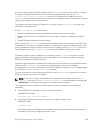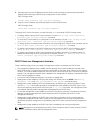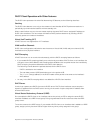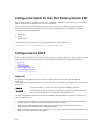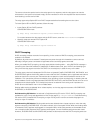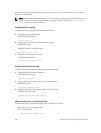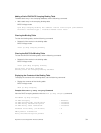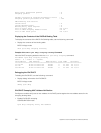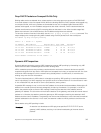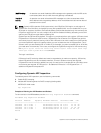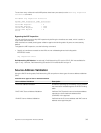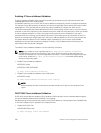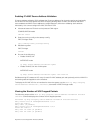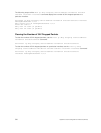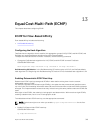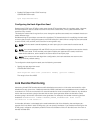
Drop DHCP Packets on Snooped VLANs Only
Binding table entries are deleted when a lease expires or the relay agent encounters a DHCPRELEASE.
Line cards maintain a list of snooped VLANs. When the binding table fills, DHCP packets are dropped only
on snooped VLANs, while such packets are forwarded across non-snooped VLANs. Because DHCP
packets are dropped, no new IP address assignments are made. However, DHCP release and decline
packets are allowed so that the DHCP snooping table can decrease in size. After the table usage falls
below the maximum limit of 4000 entries, new IP address assignments are allowed.
To view the number of entries in the table, use the show ip dhcp snooping binding command. This
output displays the snooping binding table created using the ACK packets from the trusted port.
Dell#show ip dhcp snooping binding
Codes : S - Static D - Dynamic
IP Address MAC Address Expires(Sec) Type VLAN Interface
================================================================
10.1.1.251 00:00:4d:57:f2:50 172800 D Vl 10 Te 1/2/1
10.1.1.252 00:00:4d:57:e6:f6 172800 D Vl 10 Te 1/1/1
10.1.1.253 00:00:4d:57:f8:e8 172740 D Vl 10 Te 1/3/1
10.1.1.254 00:00:4d:69:e8:f2 172740 D Vl 10 Te 1/5/1
Total number of Entries in the table : 4
Dynamic ARP Inspection
Dynamic address resolution protocol (ARP) inspection prevents ARP spoofing by forwarding only ARP
frames that have been validated against the DHCP binding table.
ARP is a stateless protocol that provides no authentication mechanism. Network devices accept ARP
requests and replies from any device. ARP replies are accepted even when no request was sent. If a client
receives an ARP message for which a relevant entry already exists in its ARP cache, it overwrites the
existing entry with the new information.
The lack of authentication in ARP makes it vulnerable to spoofing. ARP spoofing is a technique attackers
use to inject false IP-to-MAC mappings into the ARP cache of a network device. It is used to launch man-
in-the-middle (MITM), and denial-of-service (DoS) attacks, among others.
A spoofed ARP message is one in which the MAC address in the sender hardware address field and the IP
address in the sender protocol field are strategically chosen by the attacker. For example, in an MITM
attack, the attacker sends a client an ARP message containing the attacker’s MAC address and the
gateway’s IP address. The client then thinks that the attacker is the gateway, and sends all internet-bound
packets to it. Likewise, the attacker sends the gateway an ARP message containing the attacker’s MAC
address and the client’s IP address. The gateway then thinks that the attacker is the client and forwards all
packets addressed to the client to it. As a result, the attacker is able to sniff all packets to and from the
client.
Other attacks using ARP spoofing include:
Broadcast An attacker can broadcast an ARP reply that specifies FF:FF:FF:FF:FF:FF as the
gateway’s MAC address, resulting in all clients broadcasting all internet-bound
packets.
Dynamic Host Configuration Protocol (DHCP)
313



